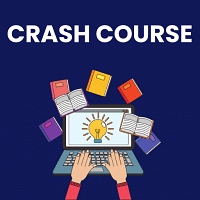UGC NET Exam > UGC NET Questions > McKinsey Co. has proposed the Seven ‘S&...
Start Learning for Free
McKinsey Co. has proposed the Seven ‘S’ Model for successful :
- a)Strategy Generation
- b)Strategy Implementation
- c)Strategic Success
- d)Strategic Achievement
Correct answer is option 'B'. Can you explain this answer?
| FREE This question is part of | Download PDF Attempt this Test |
Most Upvoted Answer
McKinsey Co. has proposed the Seven ‘S’ Model for successf...
The correct answer is Strategy implementation.
Strategy Implementation:
- Strategy implementation is the process of turning plans into action to reach a desired outcome.
- Essentially, it's the art of getting stuff done.
- The success of every organization rests on its capacity to implement decisions and execute key processes efficiently, effectively, and consistently.
Key Points
- The McKinsey 7-S Model is a change framework based on a company’s organizational design.
- McKinsey Co. has proposed the Seven ‘S’ Model for successful Strategy Implementation.
- It aims to depict how change leaders can effectively manage organizational change by strategizing around the interactions of seven key elements: structure, strategy, system, shared values, skill, style, and staff.
- The model highlights that there exists a domino effect when any one element is transformed to restore effective balance.
- The central placement of shared values emphasizes that a strong change culture impacts all the other elements to drive change.
Important Points
The seven key elements of the McKinsey 7-S Model are:
The seven key elements of the McKinsey 7-S Model are:
- Structure
- Strategy
- System
- Shared Values
- Skill
- Style
- Staff
Hence, McKinsey Co. has proposed the Seven ‘S’ Model for successful Strategy Implementation.
Free Test
FREE
| Start Free Test |
Community Answer
McKinsey Co. has proposed the Seven ‘S’ Model for successf...
The correct answer is Strategy implementation.
Strategy Implementation:
- Strategy implementation is the process of turning plans into action to reach a desired outcome.
- Essentially, it's the art of getting stuff done.
- The success of every organization rests on its capacity to implement decisions and execute key processes efficiently, effectively, and consistently.
Key Points
- The McKinsey 7-S Model is a change framework based on a company’s organizational design.
- McKinsey Co. has proposed the Seven ‘S’ Model for successful Strategy Implementation.
- It aims to depict how change leaders can effectively manage organizational change by strategizing around the interactions of seven key elements: structure, strategy, system, shared values, skill, style, and staff.
- The model highlights that there exists a domino effect when any one element is transformed to restore effective balance.
- The central placement of shared values emphasizes that a strong change culture impacts all the other elements to drive change.
Important Points
The seven key elements of the McKinsey 7-S Model are:
The seven key elements of the McKinsey 7-S Model are:
- Structure
- Strategy
- System
- Shared Values
- Skill
- Style
- Staff
Hence, McKinsey Co. has proposed the Seven ‘S’ Model for successful Strategy Implementation.
Attention UGC NET Students!
To make sure you are not studying endlessly, EduRev has designed UGC NET study material, with Structured Courses, Videos, & Test Series. Plus get personalized analysis, doubt solving and improvement plans to achieve a great score in UGC NET.

|
Explore Courses for UGC NET exam
|

|
Similar UGC NET Doubts
McKinsey Co. has proposed the Seven ‘S’ Model for successful :a)Strategy Generationb)Strategy Implementationc)Strategic Successd)Strategic AchievementCorrect answer is option 'B'. Can you explain this answer?
Question Description
McKinsey Co. has proposed the Seven ‘S’ Model for successful :a)Strategy Generationb)Strategy Implementationc)Strategic Successd)Strategic AchievementCorrect answer is option 'B'. Can you explain this answer? for UGC NET 2024 is part of UGC NET preparation. The Question and answers have been prepared according to the UGC NET exam syllabus. Information about McKinsey Co. has proposed the Seven ‘S’ Model for successful :a)Strategy Generationb)Strategy Implementationc)Strategic Successd)Strategic AchievementCorrect answer is option 'B'. Can you explain this answer? covers all topics & solutions for UGC NET 2024 Exam. Find important definitions, questions, meanings, examples, exercises and tests below for McKinsey Co. has proposed the Seven ‘S’ Model for successful :a)Strategy Generationb)Strategy Implementationc)Strategic Successd)Strategic AchievementCorrect answer is option 'B'. Can you explain this answer?.
McKinsey Co. has proposed the Seven ‘S’ Model for successful :a)Strategy Generationb)Strategy Implementationc)Strategic Successd)Strategic AchievementCorrect answer is option 'B'. Can you explain this answer? for UGC NET 2024 is part of UGC NET preparation. The Question and answers have been prepared according to the UGC NET exam syllabus. Information about McKinsey Co. has proposed the Seven ‘S’ Model for successful :a)Strategy Generationb)Strategy Implementationc)Strategic Successd)Strategic AchievementCorrect answer is option 'B'. Can you explain this answer? covers all topics & solutions for UGC NET 2024 Exam. Find important definitions, questions, meanings, examples, exercises and tests below for McKinsey Co. has proposed the Seven ‘S’ Model for successful :a)Strategy Generationb)Strategy Implementationc)Strategic Successd)Strategic AchievementCorrect answer is option 'B'. Can you explain this answer?.
Solutions for McKinsey Co. has proposed the Seven ‘S’ Model for successful :a)Strategy Generationb)Strategy Implementationc)Strategic Successd)Strategic AchievementCorrect answer is option 'B'. Can you explain this answer? in English & in Hindi are available as part of our courses for UGC NET.
Download more important topics, notes, lectures and mock test series for UGC NET Exam by signing up for free.
Here you can find the meaning of McKinsey Co. has proposed the Seven ‘S’ Model for successful :a)Strategy Generationb)Strategy Implementationc)Strategic Successd)Strategic AchievementCorrect answer is option 'B'. Can you explain this answer? defined & explained in the simplest way possible. Besides giving the explanation of
McKinsey Co. has proposed the Seven ‘S’ Model for successful :a)Strategy Generationb)Strategy Implementationc)Strategic Successd)Strategic AchievementCorrect answer is option 'B'. Can you explain this answer?, a detailed solution for McKinsey Co. has proposed the Seven ‘S’ Model for successful :a)Strategy Generationb)Strategy Implementationc)Strategic Successd)Strategic AchievementCorrect answer is option 'B'. Can you explain this answer? has been provided alongside types of McKinsey Co. has proposed the Seven ‘S’ Model for successful :a)Strategy Generationb)Strategy Implementationc)Strategic Successd)Strategic AchievementCorrect answer is option 'B'. Can you explain this answer? theory, EduRev gives you an
ample number of questions to practice McKinsey Co. has proposed the Seven ‘S’ Model for successful :a)Strategy Generationb)Strategy Implementationc)Strategic Successd)Strategic AchievementCorrect answer is option 'B'. Can you explain this answer? tests, examples and also practice UGC NET tests.

|
Explore Courses for UGC NET exam
|

|
Suggested Free Tests
Signup for Free!
Signup to see your scores go up within 7 days! Learn & Practice with 1000+ FREE Notes, Videos & Tests.
























